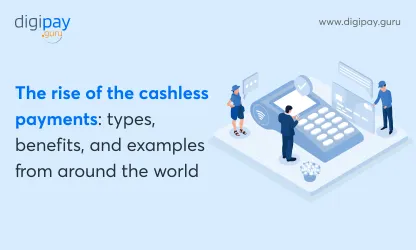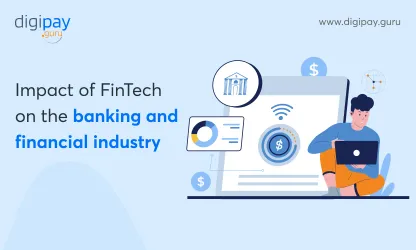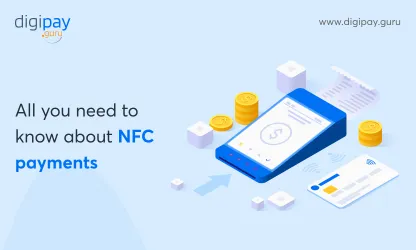In today's fast-paced world, convenience is everything. Customers demand quick and hassle-free solutions to their banking needs, and banks are turning to digital onboarding to meet these expectations.
Digital onboarding is a process that allows customers to open accounts and access banking services online, without the need for physical branch visits. This technology is gaining traction globally, with Africa being no exception.
With more than 400 million adults in Africa lacking access to formal financial services, digital onboarding has the potential to transform the banking landscape on the continent.
In fact, according to a recent study by the McKinsey Global Institute, digital financial services could add up to $300 billion to Africa's economy by 2025. Moreover, digital onboarding presents several benefits to customers, including faster account opening, improved security, and 24/7 access to banking services.

In this blog, we will explore the importance of digital onboarding on customer for banking, with a focus on the benefits it provides to customers in Africa while also helping banks to expand their reach and improve customer satisfaction.
How does digital onboarding for banking work?
In today's digital age, banking institutions have shifted their focus towards digital onboarding to provide a seamless and convenient customer experience.
Digital onboarding refers to the process of opening a bank account through an online platform or mobile application. This process eliminates the need for in-person visits to a bank branch, saving customers time and effort.
Digital onboarding involves a series of steps that ensure the customer's identity is verified and their information is accurate.
The steps involved in digital onboarding for banking
Account Opening
Customers are required to fill out an online application form that includes personal information such as name, address, and contact details. They may also be required to provide information on their employment status and income.
Identity Verification
To ensure the accuracy of the customer's information, digital onboarding in banking requires the verification of their identity. This is usually done through a two-factor authentication process that may involve sending a code to the customer's phone or email.
KYC (Know Your Customer) Requirements
Banks must comply with regulatory requirements, such as KYC regulations, to ensure that their customers are not involved in money laundering or terrorist financing. The KYC process involves verifying the customer's identity, residential address, and income sources.
Funding the Account
Once the customer's identity is verified, they can fund their account through online transfers or by linking their debit or credit card.
Technologies used in digital onboarding
Several technologies are used in digital onboarding to ensure the process is secure and efficient. These technologies include:
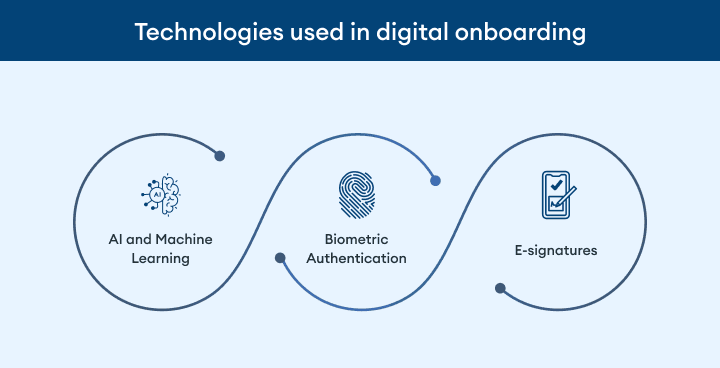
AI and Machine Learning
These technologies can analyze large volumes of data to detect fraud and suspicious activity, ensuring that the customer's information is safe and secure.
Biometric Authentication
Biometric authentication uses physical characteristics such as fingerprints, voice recognition, or facial recognition to verify the customer's identity, ensuring that the person opening the account is who they claim to be. This helps in improving the security and privacy of both digital onboarding processes and digital payments.
E-signatures
E-signatures allow customers to sign documents electronically, eliminating the need for physical signatures and making the process more convenient.
Even customers in rural areas or those with limited access to technology can still use digital onboarding solutions. Banks have developed user-friendly platforms that can be accessed through a mobile phone or computer.
Additionally, some banks have established partnerships with local agents, who can assist customers with the digital onboarding process. This makes it possible for customers in rural areas to access banking services without the need for physical branches.
Benefits of Digital Onboarding for Banks
Digital onboarding for banks offers several benefits for both customers and financial institutions. With the rise of digital transformation, banks have shifted towards digital onboarding to provide a seamless and efficient customer experience.
Here are some advantages of digital onboarding for banks:
Convenience and Speed
Access to Digital Services
Digital onboarding provides customers with access to a range of digital services such as online banking, mobile banking, and e-statements. This allows customers to manage their accounts anytime and anywhere, without the need for physical branches.
Reduced Wait Times
Digital onboarding eliminates the need for in-person visits to a bank branch, reducing wait times and making the process faster and more convenient.
Enhanced Security
Verification and Authentication Processes
Digital onboarding uses advanced verification and authentication processes to ensure the customer's identity is verified and their information is secure. This reduces the risk of fraud and ensures that the customer's data is protected.
Document and Data Encryption
Digital onboarding uses encryption technology to protect customer data and documents, ensuring that they are safe from unauthorized access or theft.
Better User Experience
Personalized Service and Support
Digital onboarding provides customers with personalized service and support through chatbots, online support, and mobile applications. This improves the customer experience and reduces the need for in-person interactions.
Reduced Paperwork
Digital onboarding eliminates the need for physical paperwork, reducing the administrative burden on banks and making the process more efficient.
Moreover, in Africa, digital onboarding has become increasingly popular, with banks adopting technologies such as mobile apps and USSD codes to provide customers with a seamless and convenient banking experience.
For example, some African banks have developed advanced mobile money payment solutions like mobile apps that allow customers to open bank accounts, transfer money, and pay bills using their smartphones.
Additionally, USSD codes are being used to provide customers with access to banking services through their mobile phones, without the need for an internet connection. These technologies have made it possible for customers in rural areas or those with limited access to technology to access banking services conveniently and efficiently.
Challenges of Digital Onboarding in the banking landscape
Digital onboarding in the banking landscape offers numerous benefits to both customers and financial institutions. However, there are also challenges that banks face when implementing digital onboarding processes.
Here are some of the challenges of digital onboarding in the bank:
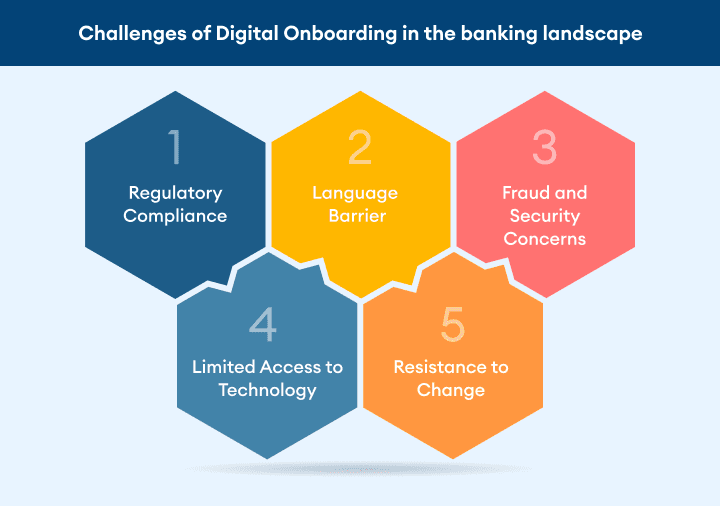
Regulatory Compliance
Banks must comply with various regulations and laws when onboarding customers digitally. These regulations may vary depending on the jurisdiction, making it challenging for banks to keep up with the constantly evolving compliance requirements.
Language Barrier
Digital onboarding may be challenging for customers who are not fluent in the language used in the digital process. This can create a barrier for customers who may struggle to understand the information required or the steps involved in the onboarding process.
Fraud and Security Concerns
Digital onboarding poses security risks, including the risk of identity theft, fraud, and data breaches. Banks must implement adequate security measures to protect customer data and prevent unauthorized access.
Limited Access to Technology
Not all customers have access to technology or the Internet, particularly in rural areas or developing countries. This can make it difficult for banks to onboard customers digitally and may exclude certain segments of the population from accessing banking services.
Resistance to Change
Some customers may be resistant to change and prefer traditional methods of onboarding, such as visiting a physical branch. Banks must find ways to educate customers on the benefits of digital onboarding and ensure that the process is easy to use and understand.
Best Practices in digital onboarding for a hassle-free banking Experience
Digital onboarding has become an essential part of the banking landscape, providing customers with a hassle-free and convenient banking experience.
However, to ensure the success of customer digital onboarding, banks must implement best practices that promote ease of use, security, and customer satisfaction.
Here are some best practices for digital customer onboarding:
Clear and Simple Instructions
Digital onboarding processes should be easy to understand and follow, with clear instructions that guide customers through each step of the process. Banks should also provide customers with support and assistance if they encounter any issues or have questions.
Seamless Integration with Other Systems
Digital onboarding should be seamlessly integrated with other banking systems, such as online banking and mobile banking. This ensures that customers can access all their banking services through one platform, without the need to switch between different systems.
Personalized Support and Assistance
Banks should provide personalized support and assistance to customers during the onboarding process. This can include chatbots, online support, and customer service representatives who can provide assistance in multiple languages.
Regular Updates and Notifications
Customers should receive regular updates and notifications during the onboarding process, keeping them informed of the progress and any additional steps required. This helps to reduce customer anxiety and ensures that the onboarding process is completed smoothly.
Compliant processes and updates
Banks must ensure that their digital onboarding processes comply with regulatory requirements, and regularly update their systems to reflect any changes in the regulations.
Multiple language support
Banks should offer onboarding instructions and support in multiple languages to cater to customers who may not be fluent in the primary language.
Security measures in place
Banks must implement robust security measures, such as biometric authentication and data encryption, to protect customer data and prevent fraud.
Varied access options
Banks should provide alternative options for customers who do not have access to technology or the Internet, such as phone-based onboarding or in-person support at bank branches.
Popular Case Studies of Successful Digital Onboarding in Banking
As the banking industry moves towards digital transformation, digital onboarding has become an essential part of the customer journey.
In recent years, many banks have successfully implemented digital onboarding strategies to improve the customer experience, reduce costs, and increase operational efficiency.
Here are some popular case studies of successful digital customer onboarding in banking:
JPMorgan Chase
JPMorgan Chase carried out a digital onboarding process that allows customers to open an account within minutes.
The bank uses facial recognition technology and mobile check deposit to verify customer identities and fund accounts. The result has been a significant increase in new accounts and customer satisfaction.
DBS Bank
DBS Bank implemented a digital onboarding process allowing customers to open an account using their mobile devices. The bank uses biometric authentication and facial recognition technology to verify customer identities.
The result has been a 75% reduction in the time it takes to open an account and a significant increase in customer satisfaction.
BBVA
BBVA implemented a digital onboarding process that allows customers for accounts opening using their mobile devices or the bank's website. The bank uses digital signatures and biometric authentication to verify customer identities. The result has been a significant increase in new accounts and customer satisfaction.
Barclays Bank
Barclays Bank executed a digital onboarding process that allows customers to open an account online in under ten minutes.
The bank uses mobile and desktop verification processes to verify customer identities, and customers can also use biometric authentication to access their accounts. The result has been a significant increase in new accounts and customer satisfaction.
Wells Fargo
Wells Fargo’s digital onboarding process allows customers to open an account online or via the bank's mobile app.
The bank uses facial recognition technology and mobile check deposit to verify customer identities and fund accounts. The result has been a significant increase in new accounts and customer satisfaction.
Bank of America
Bank of America executed a digital onboarding process that enables customers to open an account online or via the bank's mobile app. The bank uses digital signatures and biometric authentication to verify customer identities. The result has been a significant increase in new accounts and customer satisfaction.
Conclusion
In conclusion, digital onboarding has emerged as a critical tool for banks to attract and retain customers, improve operational efficiency, and reduce costs. The benefits it provides can enhance the future of digital onboarding through its convenience, enhanced security, better user experience, and reduced paperwork.
However, the challenges of regulatory compliance, fraud and security concerns, and limited access to technology must be addressed to ensure successful implementation. As the world becomes increasingly digitized, banks need to embrace digital onboarding as a means of financial inclusion.
By providing customers with seamless, secure, and personalized digital onboarding experiences, banks can attract a wider range of customers, including those in rural areas or with limited access to technology.
At DigiPay.Guru, we are committed to facilitating digital onboarding and providing a hassle-free banking experience to customers. Our innovative solutions, including mobile apps and USSD codes, enable customers to open accounts, verify their identities, and access financial services quickly and securely.


